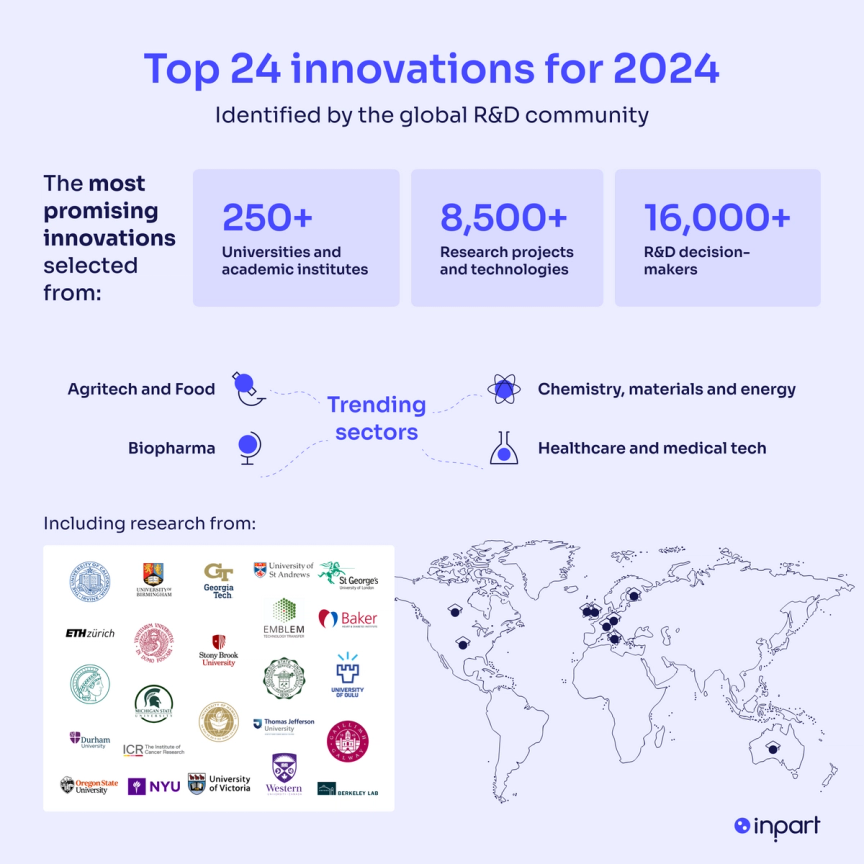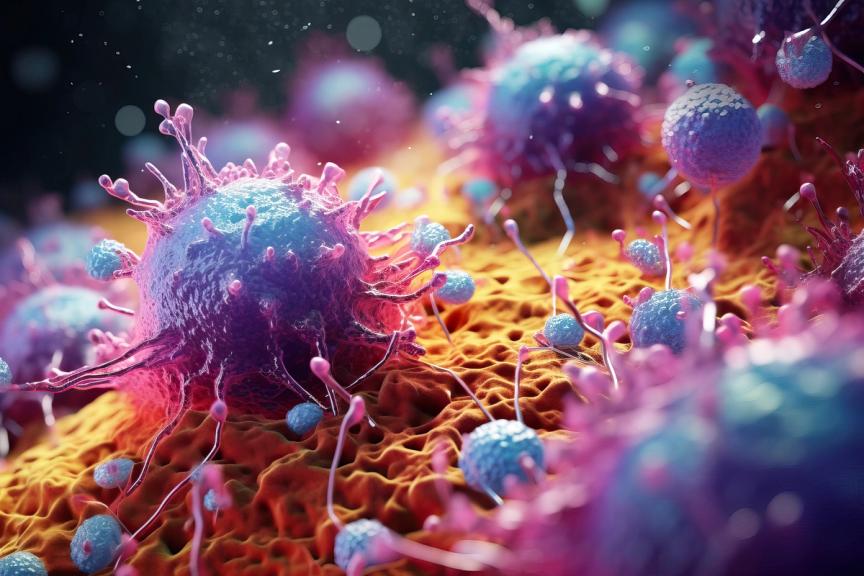Our top innovations for 2024 list is unique. Firstly, it focuses on scientific innovation - technical advances and discoveries made by academic teams working in laboratories around the world. And second, they have been identified by industry R&D leads searching for their next academic partner - the most promising candidates being taken forwards into R&D pipelines for validation and co-development. One day they could form part of a medicine that will save a life, or infrastructure helping take carbon out of the atmosphere.
The top innovations that feature in this list received the most engagement from R&D leads and open innovation professionals using our free-to-access online partnering network (create an account here) in 2023. We measure ‘engagement’ here as a weighted metric combining total article reads and the number of introduction requests to the academic team on the network.
R&D and innovation open teams in over 6,000 companies are registered to our online partnering network. This includes global leaders like J&J, Sanofi, Merck, Bayer, BASF, Unilever, Dyson, Google X, and Samsung. But it’s also home to smaller, specialized firms seeking to innovate by gaining from expertise and ingenuity being developed in academic institutes.
This list is for everyone, but if you work in industry and you want to learn more about any of these projects, or 8,500+ other live opportunities from academic institutes, biotech companies, and startups - all seeking engagement from potential partners - please start by creating an account on our partnering network so that you can read the technical project summaries and engage directly with the teams behind them.
What are the top scientific innovations for 2024?
The top scientific innovations for 2024 come from academic teams around the world working on agriculture and food sustainability, biopharmaceutical research, healthcare and medical technologies, and innovations in chemistry, materials and energy. These topics were identified by the global R&D community to have significant potential for the future.

Biopharma innovations

A new method to more quickly diagnose Parkinson’s disease
Diagnosing Parkinson’s disease can be difficult and wait-times for a definitive and clear diagnosisis often long and costly. This is primarily due to the requirement of using electronic imaging tools (PET, MRI, SPECT, etc.) and the assessment of clinical symptoms only. This presents an unmet need in medicine for a direct test that can substantially speed up diagnosis in combination with existing methods.
Scientists at the University of Galway have developed a new diagnostic method for Parkinsons’ disease, aiming to mitigate long wait times. The technology uses four blood-based protein biomarkers that can be detected in serum. Using these biomarkers in combination with existing strategies will allow diagnosis and subsequent treatment of Parkinsons’ to be improved. The scientists have also detailed the potential for the biomarker panel to determine the extent of neurodegeneration and disease stage.
Using non-coding RNAs to identify new approaches to cancer
Non-coding RNAs (IncRNA) are often overlooked in the search for new cancer drugs, as many are yet to be characterized. IncRNAs have regulatory functions, which in cancer cells are mutated or expressed differently, thus there is a pressing need to characterize them to reveal their true potential for cancer treatments.
Using this knowledge, a team of researchers working at ETH Zurich have found a novel IncRNA that activates an evolutionary conserved tumor suppression mechanism. Additionally, through laboratory experiments, they found that let-A RNA has included cell death in many human cancers, but not non-tumor cells. As such, this IncRNA can prove to be a promising candidate for cancer treatment, with less production cost than for proteins or polypeptides.
A new first-in-class therapy for heart failure
Diastolic heart failure, also known as heart failure with preserved ejection fraction, is estimated to affect at least 85-million people worldwide. Because of its complicated pathophysiology and a lack of effective therapies, this condition is associated with a lower quality of life, highlighting the unmet medical needs of those affected.
To reduce inflammation and cardiac fibrosis from heart failure, Baker Institute researchers have developed a soluble small molecule with potent anti-inflammatory and anti-fibrotic action at low doses. In preclinical mouse models of heart failure, the compound demonstrated ability to enhance cardiac function and reduce inflammation and fibrosis compared with the current standard care of treatment. This suggests promise for a new and effective treatment for diastolic heart failure patients.
A new CAR-T therapy target halting tumor metastasis
There are around 55,900 new cases of breast cancer in the UK every year, the fourth most common cause of cancer death in the UK. The majority of breast cancer deaths are due to metastatic evolution of the disease. Novel clinical targets can be identified by characterizing interactions between the tumor cell and tumor microenvironment that contribute to metastasis.
Scientists at the Institute of Cancer Research have identified endosialin as a target. Endosialin is a transmembrane receptor with limited expression in healthy tissues but strongly promotes spontaneous metastasis of tumors. The researchers tested endosialin-directed CAR-T cells in a breast cancer mouse model, resulting in significant growth inhibition and necrosis of the primary tumor, without affecting normal tissue. This shows promise that endosialin CAR-T therapy could be a viable option to treat not only breast cancer but also other solid tumors and metastatic cancers.
A humanized antibody stopping fibrotic disease in its tracks
Collagen is the most abundant protein in the human body. It combines with minerals to form our bones and teeth, gives strength and elasticity to our tendons, and is also a major component of our corneas, blood vessels, gut, and skin. However, when collagen production goes wrong, tough fibrotic scar tissue is formed that if left unchecked can quickly lead to organ failure.
Although fibrotic diseases are highly progressive and can occur throughout the body, no fully effective intervention exists to treat them. To meet this clinical need, researchers at Thomas Jefferson University have developed a patented humanized collagen-specific antibody that binds to collagen molecules, preventing their aggregation into insoluble fibers, and thereby blocking pathological fibrosis. Extensive testing by the researchers has shown effective treatment of fibrotic disease in model systems without alteration of healthy structural collagen. The team at Thomas Jefferson University are now looking for licensing partners help take this next-generation antibody treatment into the clinic.
A novel combination therapy improving the prospects from prostate cancer
Prostate cancer remains one of the leading causes of cancer deaths worldwide, with 1.3 million new cases each year and 360,000 associated deaths. Advancement to castrate-resistant prostate cancer (CRPC) is seen in 50% of these patients as they become resistant to androgen deprivation therapy and eventually succumb to the illness.
To combat this, a team of academics at Stony Brook University have pioneered a therapeutic platform that elicits a long-term adaptive immune response to CRPC. This therapy facilitates the generation of tumor-specific cytotoxic T-cells that kill cancer cells expressing tumor-associated antigens, preventing a major resistance pathway for prostate cancer. This combination of cytotoxic and immunostimulant treatments provides enhanced clinical outcomes, and is likely to save non-responding patients, potentially resulting in long-term remission and immunity to prostate cancer.
Overcoming limitations in gene editing to improve therapies and diagnostics
Targeted genome modification is a powerful therapeutic tool for human genetic diseases, but current methods using CRISPR face limitations. HyEdit, a breakthrough technology developed by researchers at the European Molecular Biology Laboratory, aims to address these challenges. Their artificial system utilizes RNA-guided nucleases for more precise genome editing in therapeutic and diagnostic applications.
The European Molecular Biology Laboratory overcomes limitations in genome editing by being fully independent of sequence motifs and having high specificity even for highly repetitive genomic regions. The protein component the technology allows for adenovirus packaging and localization into organelles, enabling mitochondrial or chloroplast DNA editing. Available for out-licensing and co-development, HyEdit presents a novel opportunity in the advancement of genome editing.
Agriculture and food sustainability innovations

A dual-solution biobased packaging with embedded antibacterials
Natural biopolymer development and application are critical for reducing the environmental impact of plastics. However, significant progress is needed, particularly in the food packaging sector, to decouple a reliance on fossil-fuel derived plastics. What’s more, to feed growing global populations, developments are needed to preserve the freshness and nutrient-value of food.
With these goals in mind, researchers based at Ca' Foscari University of Venice have developed an active and intelligent bio-based packaging - the world's first active material containing an antibacterial compound that is irreversibly anchored to the packaging itself. By reducing bacterial growth and extending product shelf life without introducing any additives into the food, this technology improves both the sustainability and safety of food and packaging.
Making crops more sensitive to their own growth factors
As the human population grows so does our need for crop productivity. With limited space for farming and fresh pressures arising from climate change, increasing crop yield is more important than ever. In recent history, this has been addressed by the application of chemical fertilizers. However this can cause non-specific promotion of plant growth and significant pollution as fertilizers leach from fields into the environment.
To tackle this global challenge, University of Durham scientists have developed a series of easy-to-manufacture compounds that promote plant growth by increasing sensitivity to their own naturally occurring growth hormones. Their small molecule growth promoters can be added to crops in the field or as a seed treatment, boosting both root and shoot development. Application of this technology has been demonstrated for both monocot and dicot plants and represents a vital step towards a future of more sustainable agriculture.
Identifying harmful microbes wherever they hide
Harmful microbes can be found in water, food, plants, the environment, and can be transmitted through human-to-human contact. Access to rapid and low-cost microbe detection technology is crucial to protecting the health and wellbeing of humans and animals.
With this in mind, researchers at Michigan State University have been working with novel magnetic nanoparticles capable of rapidly extracting pathogens from different substances. The nanoparticles bind with microbes, forming complexes that can be selectively separated and identified, providing an inexpensive, fast, and simple method to detect bacteria across multiple domains.
Treating complex mixed-infection threats to crops
Due to the complex and varying morphology of different pathogenic fungi and bacteria that affect a number of vital crops, it is becoming increasingly difficult to implement effective and safe disease control measures. Most control measures are unspecific, due to the absence of knowledge around effective molecular targets, leading to increased resistance from pathogenic microbes. This resistance is a threat to global crop supplies, and if left unchallenged can cause long term food chain issues.
Scientists at the Max Planck Society for the Advancement of Science have developed a new treatment approach to mitigate this resistance with unique compounds demonstrated to directly inhibit the aggregation of amyloid-like proteins within these disease-causing structures. Their research has shown that the compounds expel significant effects on the growth and spread of disease and negating the onset of resistance through specific methods of action.
Scaling up production of a bio-based sweetener to reduce obesity rates
Sweeteners are often used as a way to reduce calories and lower obesity. Although they aren’t favorable with consumers, being reported as having an unpleasant taste or the perception of being addictive. Brazzein, a natural protein found in the fruit of the Oubli shrub, has been used as a sweetener in West Africa for hundreds of years. Its sweet taste, high heat-resistance and stability makes it suitable for the food industry, however the production of this protein has not yet been economically viable.
Researchers at the University of Oulu have developed and patented a technology to purify Brazzein on a large scale. Their method is facile, cheap, scalable and only uses chemicals which can be found in a well-stocked kitchen. This provides a zero-calorie sweetener that tastes like sugar, whilst also reducing production costs for the food and beverage industry.
Healthcare and medical technology innovations

A route to deliver insulin orally that could revolutionize diabetes treatment
Diabetes affects around 10% of the global population and ranks as the 7th leading cause of death. The standard treatment, insulin therapy, faces challenges in patient adherence due to inconvenient subcutaneous injections. To combat this, academics at New York University have developed novel organic nanoparticles to allow insulin to be delivered orally.
The nanoparticles exhibit high insulin-loading capacities, resistance to acidic conditions, and the ability to traverse the intestinal barrier without inducing toxicity. The NYU innovation presents an opportunity to revolutionize diabetes care, offering a more convenient and non-invasive method. With applicability to both Type 1 and Type 2 diabetes, the researchers are seeking a strategic partner to help advance the oral insulin technology into the clinic and improve diabetes treatment.
Stabilizing the delivery of nucleic acid therapeutics
Nucleic acid therapeutics have shown promise in the treatment of genetic disorders, infectious disease, and cancer. Their delivery, however, poses a challenge because nucleic acids are highly charged and easily degrade. Therefore, they require a delivery system that can improve stability, facilitate uptake, and increase target affinity.
Polymeric nanoparticles have become a focus as a nucleic acid delivery tool due to their relative stability, propensity for functionalization, and tunability. Building on this knowledge, University of Victoria scientists have developed a polymeric nanoparticle with a hydrophobic core to enable the stable encapsulation and controlled release of nucleic acids. Applications include gene therapy, vaccine delivery and other drug delivery.
Enabling self-administration of glaucoma therapeutics
Glaucoma is a serious eye condition that leads to blindness and affects millions of people worldwide. Existing treatments for glaucoma either require experienced practitioners to give the drug or the administration of self-treatments that are difficult for patients.
A team of scientists working at the Georgia Institute of Technology have developed a new device that can deliver therapeutic agents for glaucoma to the subconjunctival space of the eye. Their single-button device revolutionizes the administration of glaucoma therapeutics. Its user-friendly design, requiring only one hand for operation, makes it safer and easier for individuals with glaucoma to self-administer the drug as well as maintain compliance with their prescription.
The next step in wearable healthcare diagnostics
In the ever-advancing landscape of healthcare, wearable technologies have emerged as powerful tools to enhance patient outcomes and reduce costs. Researchers at the University of Hawai'i are contributing to this landscape with their novel 'sweat sticker' technology. Leveraging stereolithography-based 3D printing, the researchers’ flexible, stretchable devices offer real-time, non-invasive analysis of sweat and allowing personalized health assessments. The streamlined prototyping process enables rapid fabrication, ensuring user-friendly, mobile-accessible devices.
This approach addresses the need for multiple sample collections in a single setting, presenting a cost-effective solution with vast applications in wearable technologies and healthcare diagnostics. The technology has potential to greatly improve personalized health assessments, marking a significant stride toward accessible and efficient healthcare solutions.
Moving past injections to improve vaccine delivery
Current vaccine platforms have mixed success at preventing new emerging infectious diseases and present several limitations. With these in mind, researchers at St George’s, University of London have developed a novel protein-only based vaccine that is delivered via a respiratory route and generates mucosal immunity against COVID-19 and other diseases.
This technology provides many important benefits over injectable vaccinations. Its needle-free delivery allows for easy administration and in the absence of a trained professional, it can be self-administered. Furthermore, this simple, protein-only vaccine is producible in all conventional cell lines, ensuring affordability and safety for human application.
Chemistry, materials, and energy innovations

Driving sustainable change through EV lithium battery recycling
New solutions also create new challenges. The rise of electric vehicles has created a need to effectively recycling lithium-ion batteries. To address this, researchers at the University of Birmingham have developed a novel technology to separate battery components in an efficient process using low-cost, non-toxic chemicals and water.
The method is highly versatile, rapid, and can be applied to various cathodes, significantly reducing recycling waste, presenting an opportunity to streamline the battery recycling process with increased safety, environmental friendliness and efficiency.
A non-toxic, low-cost heat reflective coating for buildings and surfaces
Heat reflective coatings are important for global energy management, but they’re often made of toxic and costly materials. To address this, researchers at the University of California, Irvine have developed an innovative energy-efficient coating derived from a naturally occurring, inexpensive biomolecule. Their technology can be produced at a very low cost in large quantities and is fully biocompatible, reducing total life cycle costs across production, installation, and removal/replacement stages.
The novel coating is effective for reducing energy expenditures for consumers and corporations. The UCI researcher's achievement opens doors for improved energy efficiency, offering a cost-effective, biocompatible alternative for surfaces like windows, sports gear, clothing, and camping equipment.
Supercharging electric vehicle batteries with solid-state cathodes
The rapid growth of the electric vehicle market requires the development of lithium-ion batteries with higher energy and power densities, better safety, and longer lifespan. Solid-state batteries employing an inorganic solid-state electrolyte have been promoted as a breakthrough technology but development is still in an early stage.
Researchers working at Lawrence Berkeley National Laboratory have tackled this issue, developing solid-state cathodes for safe solid-state batteries with high energy/power densities and long lifecycles. Featuring halide solid electrolytes and single-crystal cathode active materials, their design reduces capacity loss, ensuring better cycling stability and improved safety compared to current lithium-ion batteries. The technology, at a proven principle stage, holds promise for scalable fabrication processes, making it a game-changer for energy storage in electric vehicles.
Upcycling high-volume plastic waste on the road to a circular economy
The three synthetic polymers produced on the largest scale are polyethylene (PE), polypropylene (PP), and polyvinyl chloride (PVC). Tens of millions of tons of each is produced annually, and recycling or reusing these materials is a critical step in our transition to a sustainable circular economy. Unfortunately, mechanical and chemical PVC recycling is commercially challenging due to the resource-intensive grinding, washing and melting steps required, and the production of harmful chlorinated byproducts.
Oregon State University researchers have developed a low temperature chemical upcycling process that can transform PVC waste into high-density PE for manufacturing, and PE waxes for the adhesives market. Their method strips the chlorine from PVC, trapping dangerous chlorinated compounds as salts, transforming this problematic polymer into a valuable replacement for virgin PE. Early-stage results have been validated and the inventors seek development partners to take their technology to market.
CornCrete- an alternative and more sustainable source of cements
Cement production is energy and carbon-intensive, contributing to approximately 7% of global industrial energy consumption and 6-8% of global greenhouse gas emissions. It is made from finely ground materials such as fly ash (a byproduct of coal mining), slag, and silica fume. And as coal use declines so too do the inputs to traditional concrete supply. Substituting the cement in concrete with more abundant cementitious materials can be a potential solution to meet our global sustainability goals.
To do this, researchers at Colorado State University have looked to corn biomass to create a supplementary cementitious material. In addition to increased sustainability, the blocks produced have improved mechanical and durability properties, and increased resistance to cracking and tensile stress.
Deriving high-value chemicals from biological sources
As we work towards a circular economy, the demand for bio-based and derived chemicals to replace traditional petrochemicals increases. One key player in the transition Is 5-hydroxymethylfurfural (5-HMF), which can be derived from sugars and carbohydrates and transformed into a variety of high-value green chemical products. However, large-scale, cost-effective production of 5-HMF remains an industrial challenge.
Researchers at Western University have pioneered a breakthrough continuous-flow biphasic reactor process to produce 5-HMF cost-effectively. Their new green approach, utilizing aqueous media and innovative catalysts, not only enhances yield and selectivity but also achieves scalability. Their technology has the potential to revolutionize green biofuel production and advance the development of bio-based polymers, contributing significantly to the global shift toward sustainable chemical manufacturing.
Curated by Emily Jones. Edited by Alex Stockham and Joseph Ferner. Contributions from April Douglas, Anh Tho Tran, Dagmara Szmaglinska, John Finnegan, Nathan Ford, Tom Roberts-McEwen, and GPT-3.5. Produced by the Inpart content and marketing team. Copyrights reserved unless otherwise agreed.
Image credits:
- Header - © [googledeepmind] / Unsplash.
- Biopharma - © [fotoyou] / Adobe Stock.
- Agriculture - © [Roxana] / Adobe Stock.
- Healthcare - © [alfa27] / Adobe Stock.
- Chemistry - © [googledeepmind] / Unsplash
If you have any questions or ideas to share about this content, our methodology, or would like to discuss how you can engage with our scientific network, contact our team via emily.jones@inpart.io


